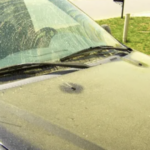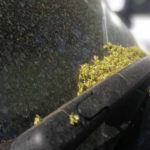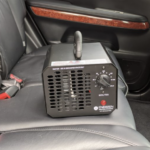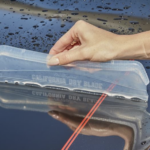From Grit to Gloss: Understanding the Science of a Clay Bar Treatment
Your vehicle’s paint is constantly exposed to harsh elements, from stubborn contaminants like industrial fallout and brake dust to tree sap and pollen. While regular car washing removes surface-level dirt, it’s often insufficient to eliminate deeply embedded particles. This is where a clay bar treatment comes into play—a transformative detailing process that removes harmful contaminants and restores your vehicle’s smooth, glossy finish. In this article, we’ll delve into the science behind clay bar treatments, their benefits, and why they’re a must for any vehicle owner seeking long-term protection and beauty.
What is a Clay Bar Treatment?
A clay bar treatment is a professional detailing process designed to lift and remove stubborn contaminants from your vehicle’s surface. The clay bar, a specially formulated resin compound, works by gliding over the paint and adhering to contaminants that have bonded with the surface.
The Components of a Clay Bar
A clay bar is made of synthetic resin that is soft yet abrasive enough to trap and lift contaminants without damaging your vehicle’s clear coat. It is always used with a clay lubricant to ensure a smooth glide and prevent scratching.
What It Targets
Clay bar treatments are highly effective in removing:
- Embedded dirt and dust particles
- Industrial fallout
- Tar and road grime
- Tree sap and bird droppings
- Pollen and brake dust
By targeting these contaminants, a clay bar treatment restores the smoothness of your vehicle’s surface and prepares it for protective coatings.
The Science Behind a Clay Bar Treatment
How Contaminants Bond to Paint
Your car’s paint, though glossy and smooth to the eye, has microscopic pores where contaminants settle and bond. These particles are often chemically adhered to the surface due to heat, UV exposure, and environmental moisture, making them resistant to traditional washing methods.
How a Clay Bar Works
The clay bar is designed to grab and lift these contaminants from the pores of the paint. When used with a lubricant, the bar glides over the surface, trapping particles within its resin structure. This mechanical action removes the embedded debris without scratching or damaging the paint.
Why is a Clay Bar Treatment Essential?
1. Restores Surface Smoothness
One of the most immediate benefits of a clay bar treatment is the restored smoothness of your car’s surface. A smooth surface not only looks better but also improves the application and durability of protective coatings like wax or sealants.
2. Prevents Long-Term Damage
Contaminants left on the surface can break down your car’s clear coat over time, leading to oxidation, fading, and even rust. A clay bar treatment eliminates these risks by removing harmful particles.
3. Enhances Shine and Gloss
By removing contaminants that dull the paint, a clay bar treatment brings back your vehicle’s vibrant color and reflective shine. It’s the perfect way to achieve that showroom look.
4. Prepares for Waxing or Polishing
Wax and polish adhere better to a clean, contaminant-free surface. A clay bar treatment ensures that your vehicle is ready for these protective steps, enhancing their effectiveness and longevity.
The Process of a Clay Bar Treatment
Clay bar treatments follow a step-by-step process to ensure maximum effectiveness without damaging the paint:
1. Initial Wash
The vehicle is thoroughly washed to remove loose dirt and grime. This step prevents scratches during the clay bar process.
2. Lubrication
A specialized clay lubricant is applied to the surface to reduce friction and allow the clay bar to glide smoothly. This step is critical for avoiding scratches.
3. Claying the Surface
The clay bar is worked over the lubricated surface in small sections using a gentle back-and-forth motion. It traps and lifts contaminants embedded in the paint.
4. Inspecting the Surface
After claying, the surface is inspected by touch and visually to ensure all contaminants have been removed. If necessary, the process is repeated in specific areas.
5. Protective Coatings
Once the surface is contaminant-free, a layer of wax, sealant, or ceramic coating is applied. This step locks in the shine and provides long-lasting protection.
Benefits of Professional Clay Bar Treatments
While DIY kits for clay bar treatments are available, professional services offer distinct advantages:
1. Expert Knowledge
Professionals understand the unique challenges of various paint types and can tailor their approach to your vehicle’s specific needs.
2. High-Quality Products
Professional detailers use premium clay bars and lubricants that deliver superior results compared to over-the-counter options.
3. Comprehensive Care
In addition to claying, professional services typically include washing, polishing, and waxing, providing a complete restoration and protection package.
4. Time Efficiency
Professional detailers complete the process efficiently, saving you the effort and ensuring perfect results every time.
Why Choose Mobile Detailing for Clay Bar Treatments?
Mobile detailing services offer the ultimate convenience for vehicle owners. Here’s why they’re an excellent option for clay bar treatments:
1. Convenience at Your Doorstep
Mobile detailers bring the expertise and equipment to your location, whether it’s your home, office, or even a parking lot.
2. Customized Services
Mobile detailing allows you to choose specific treatments, such as clay bar applications, tailored to your vehicle’s condition.
3. Top-Tier Equipment
Mobile detailers use professional-grade tools and products, ensuring your vehicle receives the best care possible.
4. Flexible Scheduling
With mobile services, you can book appointments that fit your schedule, making it easy to keep your vehicle in top shape year-round.
How Often Should You Get a Clay Bar Treatment?
The frequency of clay bar treatments depends on your vehicle’s exposure to contaminants and your maintenance routine. Here are some general guidelines:
- Every 6 Months: For most vehicles, twice a year is sufficient to remove accumulated contaminants.
- Before Waxing or Polishing: Always clay your car before applying protective coatings to ensure optimal adhesion and performance.
- After Harsh Environmental Exposure: If your car has been exposed to construction zones, industrial areas, or heavy pollen, a clay bar treatment may be necessary sooner.
Conclusion: From Grit to Gloss with Clay Bar Treatments
A clay bar treatment is an essential step in maintaining your vehicle’s appearance and protecting its paint. By removing deeply embedded contaminants, it restores smoothness, enhances gloss, and prepares your car for protective coatings. Whether you’re looking to rejuvenate an older vehicle or maintain a new one, a clay bar treatment delivers professional-level results that go beyond basic washing.
For vehicle owners in Orlando and surrounding areas, mobile detailing services make it easy to enjoy the benefits of a clay bar treatment without the hassle of visiting a shop. Schedule your appointment today and experience the transformation from grit to gloss.
Leave a Comment Cancel Comment
Book Orlando Mobile Detailing
Search
Latest Post
-
 The Cost of Neglect: Why Regular Aircraft Detailing Saves Money in the Long Run
February 14, 2025
The Cost of Neglect: Why Regular Aircraft Detailing Saves Money in the Long Run
February 14, 2025
-
 Why Car Washes Aren’t Enough to Combat Pollen Damage
February 13, 2025
Why Car Washes Aren’t Enough to Combat Pollen Damage
February 13, 2025
-
 Orlando’s Pollen Problem: When Is It the Worst and How It Affects Your Car
February 13, 2025
Orlando’s Pollen Problem: When Is It the Worst and How It Affects Your Car
February 13, 2025
-
 How Ozone Generators Eliminate Stubborn Car Odors in Orlando
February 12, 2025
How Ozone Generators Eliminate Stubborn Car Odors in Orlando
February 12, 2025
-
 Why a Water Blade and Chamois Beat Towels Every Time!
February 9, 2025
Why a Water Blade and Chamois Beat Towels Every Time!
February 9, 2025
